Marketing automation software for email, web, lead generation
Go from idea to impact in record time

Agile marketing
Innovative solutions


Real partnership
Learn about our solutions
Everything you need in a marketing automation platform

Email Marketing

Advanced Marketing Analytics
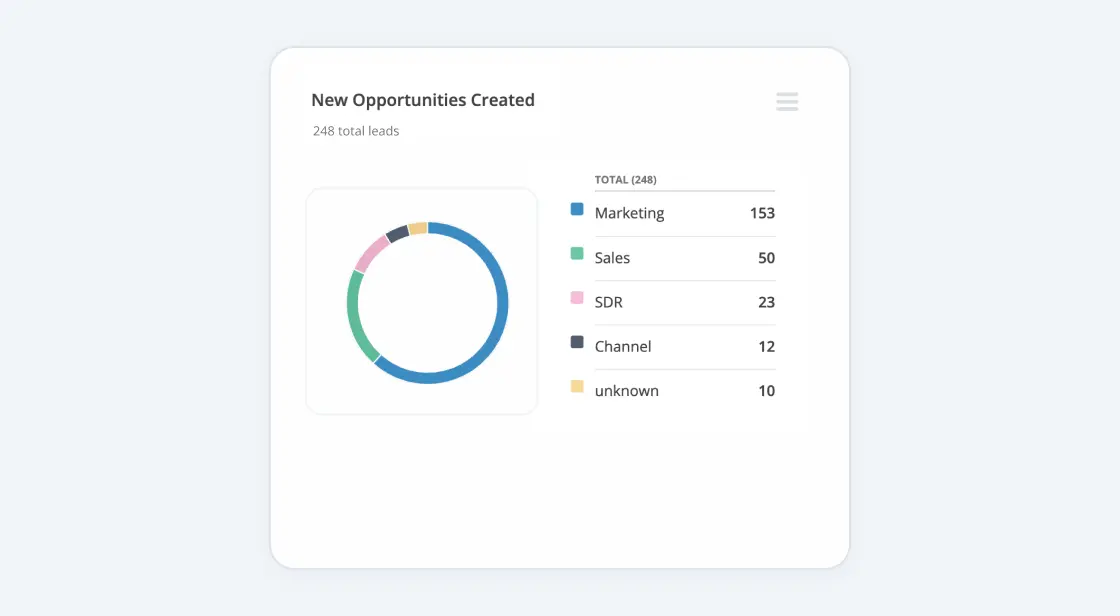
Lead Generation
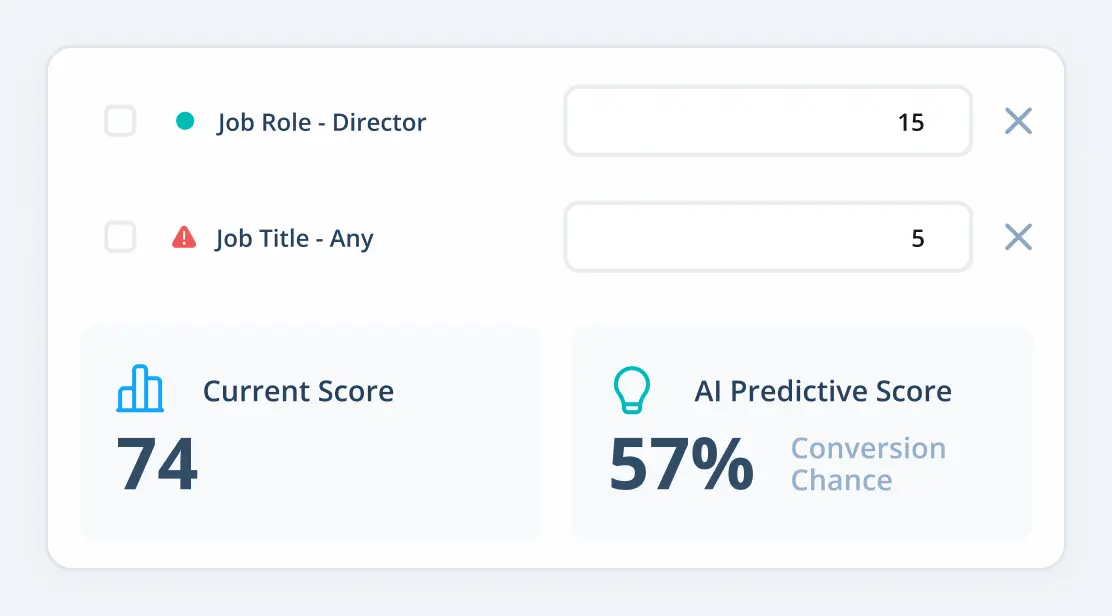
Lead Scoring

Martech and CRM Integrations
Sales Enablement
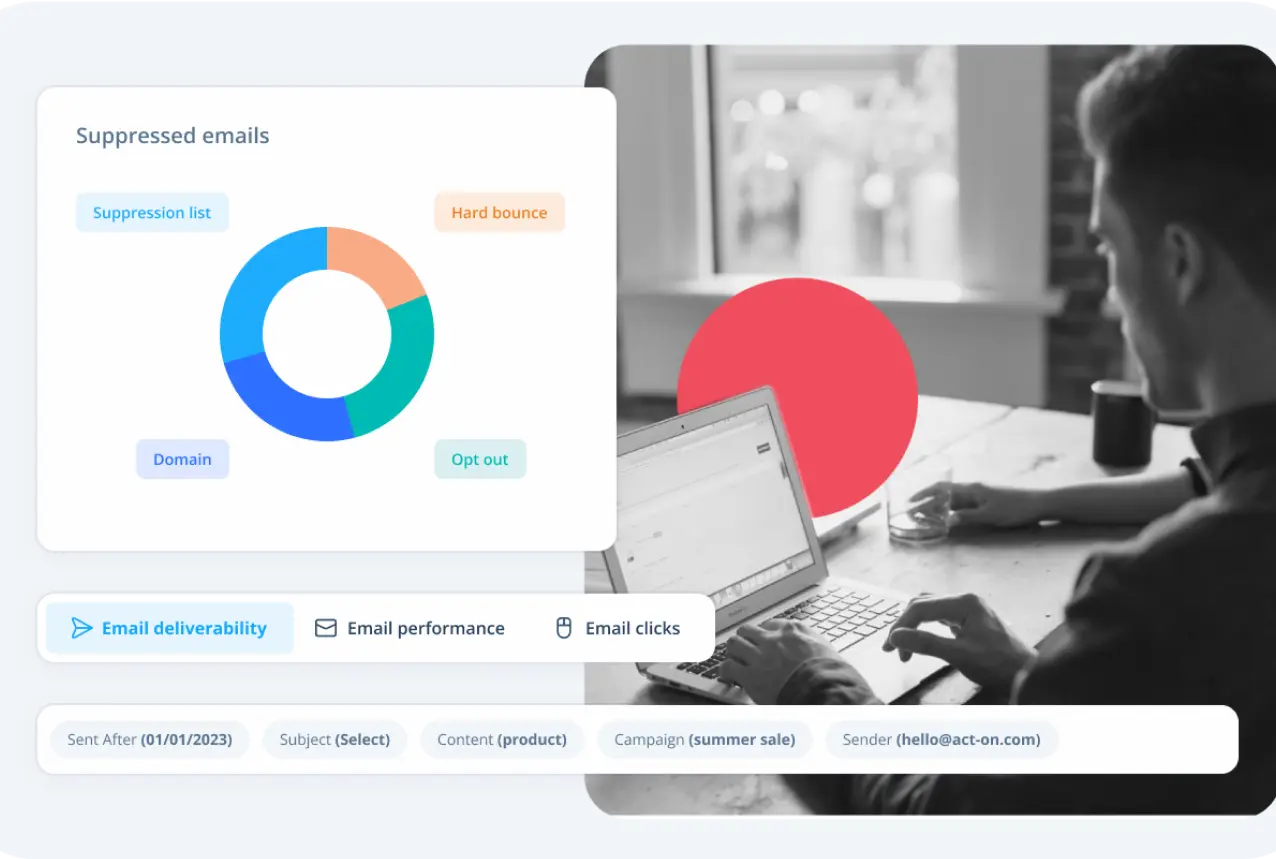
Customers Love Act-On
We’ve got the innovative tools, support services, and educational assets you need to succeed.
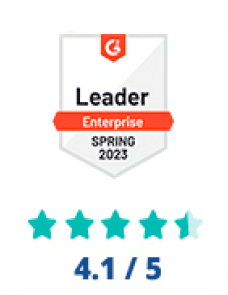



The Smartest, Easiest to Use Marketing Automation Platform

The Only Company Focused Solely on Marketing Automation Platforms
Marketing automation is the engine that drives modern digital marketing. But across the board, leading digital marketing automation platforms have stalled out. Big tech behemoths have bought up the best platforms and used them as loss leaders to sell their all-in-one, best-in-none solutions.
We believe there’s a better way. We’re the only marketing automation platform that focuses entirely on making better, easier, more intuitive solutions to help automate modern marketing departments and sales teams.
Intelligence
Apply the power of AI, machine learning, and data to build smarter, more personalized multichannel marketing campaigns.
Ease-of-Use
Build and deploy complex, segmented customer journeys easily and quickly with our modern and responsive user interface.
Openness
Use the CRMs and applications you trust, through native, open integrations, without pesky vendor lock-in requirements.

Marketing Automation Solutions
Act-On’s automated marketing platform includes the campaign automation tools you need: lead generation and lead scoring, analytics and metrics, plus support for omnichannel functions like SMS marketing and social media.
We focus on innovative marketing automation services and providing personal customer support. Most other marketing automation companies can’t honestly say that. Probably because they’re actually Big Tech wolves hiding in marketing automation sheep’s clothing: Hi Marketo, Eloqua, Pardot, and Hubspot!
Explore Act-On's Features and Capabilities
Try the Marketing Automation Platform Customers Love Using
Look, we try not to brag, but we have to be honest: Marketers love Act-On.
Maybe it’s our best-in-class customer support?
Or our competitive pricing?
Or the library of
educational assets you need to succeed?


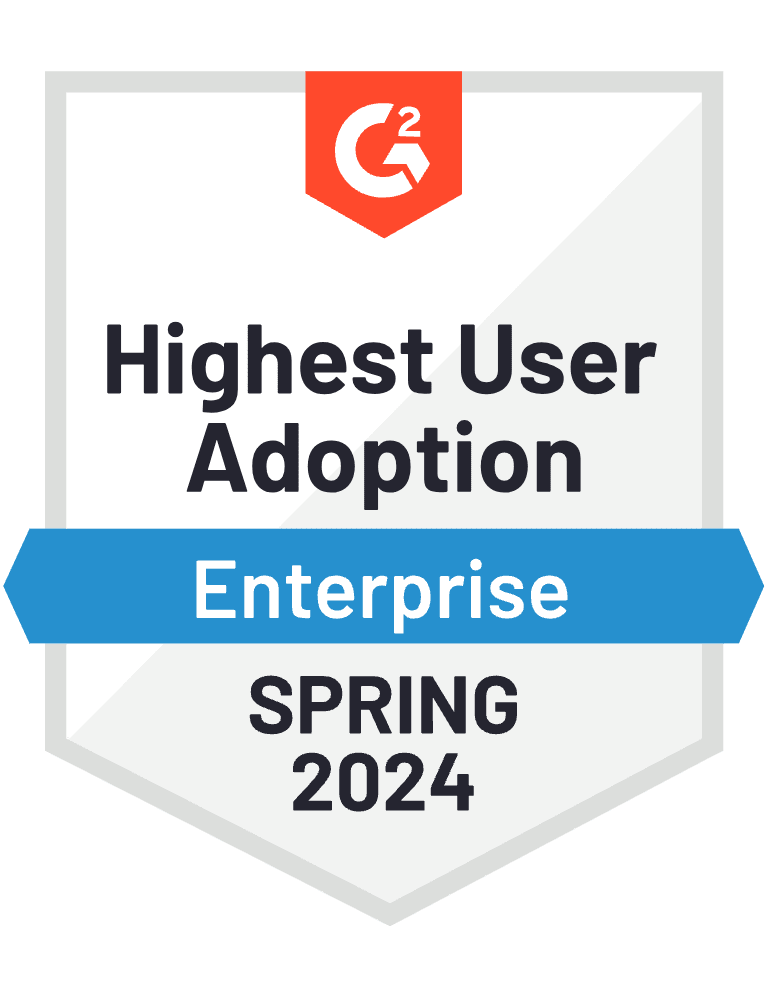








Open APIs Mean Our Marketing Automation Platform Works With Your Favorite Tools
Act-On’s native integrations with popular digital marketing software include:


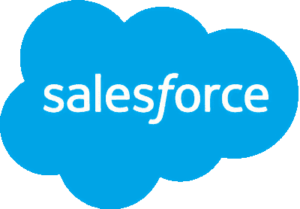





Successful Companies That Trust Act-On:
63K+
Customer experience automations monthly
4K+
Customers globally
400M+
Behaviors tracked monthly
98%
Satisfaction with Act-On customer support

Meet Act-On's Favorite People: Our Customers
We never lose sight the why behind our marketing automation services: making life easier for marketers and their customers. Act-On’s automated marketing solutions combine the best of both worlds: bleeding edge technological innovation and the kind of personalized customer support that never goes out of style.
What Act-On Customers Have to Say
Act-On gave me the insight I needed to better strategize how we engage our different audience segments.
Kristin Williams
Marketing Program Manager, Physicians Insurance

Executing our email campaigns through Act-On increased our open rates by 68% and our CTR by 25%.
Agata Krzysztofik
Chief Marketing Officer, Simscale

Act-On’s lead scoring has transformed our marketing efforts and allows us to automatically transfer great leads through our CRM.
Sam Saunders
Digital Marketing Manager, DMC Canotec

Through analytics and knowing where our customers are in their journey, we’re able to deliver the most relevant messaging.
Marc Wilensky
VP of Communications and Brand Marketing, Tower Federal Credit Union

Thanks to Act-On, we were able to enhance our marketing strategy and gain valuable insights into customer preferences.
Adam Nutting
Marketing Automation Specialist, Traverse City Tourism


Learn More About Act-On
Explore topics like marketing automation, multichannel marketing, and digital marketing strategy with our comprehensive blogs, ebooks, press releases, podcasts, and more.

ALLDATA
It’s every email marketer’s worst nightmare. A sudden spike in bounce rates. Luckily, ALLDATA had Act-On’s deliverability team on their side.

The Big Shift: How the Economy, AI, and Privacy are Changing Everything We Know About Marketing
Marketing leaders are facing an unprecedented time with unprecedented demands: we sat down with marketing leaders who bring decades of experience and a refreshingly long lens to the current moment.

Crafting A Modern Lead Story: Strategies for Effective Lead to Pipeline Conversion
We all know the classic tale: Lead meets brand. They’ve been burned by broken promises before, but this time feels different. The brand’s products solve



Marketing leaders are facing an unprecedented time with unprecedented demands: Wring every drop of value from generative AI. Navigate ever-changing email privacy regulations. Deal with the loss of third-party cookies. And reassure your CEO and board that your tech stack and team deserve to ride out this wave of economic uncertainty.
So during this season of massive change, we sat down with marketing leaders who bring decades of experience and a refreshingly long lens to the current moment, including:
- Wendy White, CMO at health and wellness SaaS platform Daxko, 30+ years in enterprise B2B marketing
- Clark Newby, strategic marketing advisor, 30+ years in B2B SaaS marketing
- Angelique Schena, Director of Marketing at Sentinel Group, 12+ years in financial services marketing
- Jeff Day, SVP of Marketing right here at Act-On, 15+ years in SaaS marketing
We asked our experts to share their top priorities, challenges, and predictions about what’s happening right now in marketing. While these leaders come from different industries, company sizes, and backgrounds, a few common themes emerged.
So let’s dive in — here’s what’s top-of-mind for these marketing leaders, along with some sage advice for their peers.

Marketing — in this economy?
The current economic headwinds are the undeniable undercurrent driving marketing leaders’ decision-making in 2024. Organizations of all shapes and sizes are slashing headcounts and freezing budgets. This is primarily due to big-picture economic factors like inflation and high interest rates, which make borrowing and securing capital difficult.
For marketers across virtually all industries, but especially those working in SaaS, this cut-mode mentality has led to fewer in-market buyers.
Much of the technology sector experienced a relative boom in the first few years of the COVID-19 pandemic, as the sudden shift to remote work drove increased investment in tech, but that time is over. “2023 was a massive wake-up call for everybody,” says Wendy. “If you work at any kind of PE or VC-backed firm, or a public firm, everybody’s feeling the same thing: boards are suddenly caring a lot more about efficiency metrics, revenue per employee, and spend metrics.”
As organizations tighten budgets and headcount, marketers tend to experience those downstream impacts as longer sales cycles and lower conversion rates.
Traditionally, sales reps can assign a higher percentage to the likelihood of a deal closing as they confirm the prospect has the budget, identify decision-makers, and move further along the buying journey. But in today’s buying market, those structures are being pressure-tested.

Clark describes prospects’ mindset as “‘FOFU mode’ — fear of ‘effing’ up.” Even if they see the value and know how they can use your product, they’re postponing making a decision due to this overriding economic uncertainty.
Sadly, macroeconomics are beyond our control. But when your prospects are moving more slowly throughout their buying journey, our marketing leaders advise their peers to prioritize full-funnel engagement.
“We care a lot about the quality and close rate of our different channels,” says Wendy. “We’re constantly looking at performance all the way through the funnel, not just what gets us volume at the front end.”
Clark believes that since prospects’ interest in purchasing is highly skewed by macroeconomics, the traditional marketing model of engaging buyers based on their level of interest — as determined by behaviors like clicks, downloads, and webinar attendance — needs to shift.
“When customer intent is tamped down overall, and is not as reliable in general, you need to think more broadly about what your funnel looks like end to end, where you think you are, and how you’re engaging with future prospects across your channels,” says Clark. “Your instruments may not properly pick up your prospects when they’re out of market. And by the time they’re in-market, your chance to communicate with them is largely over.”
Attribution in the age of privacy
The digital marketing community has been obsessing over increasing privacy regulations and the deprecation of third-party cookies — and our experts are no exception. But generally, they’re focused more on the silver linings of these changes than the end-of-the-world warnings.
Wendy and her team at Daxko had to navigate a complex landscape with multiple brands and email domains, but ultimately felt prepared when stricter email sender requirements at Google and Yahoo took effect in February. And these days, Wendy tracks their sender score and domain health score as routine metrics— which wasn’t a habit a year ago. “It’s just incremental awareness of making sure that the plumbing is working the way it should, so that your campaigns can be successful. Protecting your email domain health is super critical.”
Following best practices are the key to navigating these changes successfully, according to Jeff. “We don’t spam. We take pains to make sure our database is clean. If people opt out, we respect that. These new requirements have been a non-issue for us and for most of our Act-On customers as well. There’s a lot of people out there selling doom and gloom, but if you follow good practices, this isn’t an issue.”
In addition to dialing in on email deliverability best practices — like implementing authentication standards, optimizing for mobile, and promptly complying with unsubscribe requests — marketing leaders need to pay close attention to the reliability of common email metrics. Thanks to the proliferation of security-enhancing bots, which organizations use to open emails and check links for security purposes, our leaders report seeing artificially inflated open and click rates.
“Historically, Sentinel has put a lot of weight on our behavior scores to define an MQL and how we hand off leads to our sales development reps,” says Angelique. “But within the last few years, we’ve had more questions around that activity — like email crawlers who are opening and clicking every element of an email, and then the next thing you know, that person is an MQL. But when you dive into their activity, they’re really not.”
Both Jeff and Angelique are responding by shifting focus to downstream activities, like click outcomes and engagement rates on those pages — which happen to be far more informative about buyer intent.
“We’ve seen over the last couple of years that click rates and open rates have gone through the roof,” says Jeff. “Sometimes we get 90%+ open rates, which we know isn’t right. It’s pushed us to look at higher quality measures than these early indicator metrics. Marketers love their data, but we need to recognize what’s a real sign of actual interest and engagement.”
At Sentinel, Angelique and her team are using this shift as an opportunity to re-evaluate the weight of certain behaviors and put more stock in meaningful, hard-to-fake activities like webinar attendance.
This evolution reflects a deeper change in how Angelique evaluates her own success as a marketing leader. “For a long time, my personal goal was to generate a certain number of net-new MQLs. And I’m succeeding — but honestly, how many of these are converting? When we go deeper and really identify the ways that people are making their buying decisions — instead of only looking at email — you see things in a different way.”
For Clark, this kind of shift in perspective is welcome — and overdue. “It’s kind of ridiculous that we’re still doing everything the same way 15 years later. These changes are nudging us into a more effective, genuine, interactive, value-driven relationship with our prospects.”
AI needs to drive efficiency, not headlines
According to a study from PwC, 81% of CMOs say they expect to use GenAI to support new business models in their function in the next 12-18 months. Our marketing leaders are cautiously optimistic about the possibility of AI being adopted across the organization.
Jeff notes that while deep and meaningful adoption of AI tools are lagging behind the hype cycle, there’s untapped value available to leaders who can leverage them properly. “One of the trends we’ll see going through 2024 is that marketing teams are going to figure out how to make more use of AI, and get comfortable with it.”
Wendy agrees with Jeff’s prediction, and believes CMOs will be under increasing pressure to use AI in order to drive efficiency — in other words, to accomplish our aforementioned goal of doing more with less.
“I remember the year when ‘the cloud’ became the theme for the boards,” says Wendy. “This year’s theme for the boards is going to be AI and efficiency. They’re going to want to know, ‘Why aren’t you using AI to go faster or better? How are you driving high performance and high ROI work out of marketing?’ It’s just going to happen. If you’re not ready as a CMO, you’d better get ready.”
For example, Daxko uses AI tools to summarize release notes from integrated products or partners, share them in Slack, and notify relevant team members when there’s been an update. Previously, that was a manual task — but now, AI has taken it off somebody’s plate. And while the marketing team uses genAI tools to support content creation, they’re taking a lean approach with free or low-cost tools. “We’re doing some interesting work around using a plethora of tools versus a big heavy investment,” says Wendy. “You don’t need to buy an expensive tool in order to drive value.”
While our team here at Act-On uses generative AI tools to supplement research and ideation, Jeff has also found tremendous value by using AI in our own marketing analytics.
“Implementing AI into our analytics, including natural language processing, has changed everything for me as a VP,” says Jeff. “Now I can just ask questions like, ‘Show me the email performance for this campaign’. It’s super easy for me to go in, tweak the analysis, and gather insights — that I’d otherwise have to be spelunking around in our various software packages.”
Given the many possible applications of AI for the marketing org, Wendy is contemplating creating an AI Ops role to help organizational leaders figure out when and how to leverage AI tools, and stay on top of the quickly changing landscape.
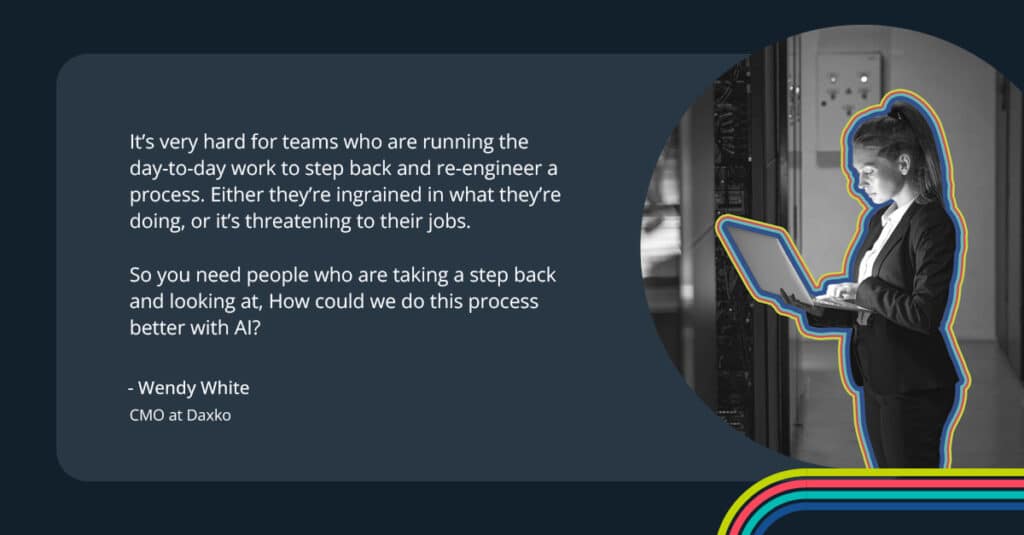
Customer retention takes center stage
Customer retention often plays second fiddle to acquisition. But given the likelihood of fewer in-market leads and longer sales cycles, our leaders say customer retention has never been more important. And marketers are stepping up to the plate — marketing is now involved in the ownership of CX at ~84% of organizations.
“In terms of business planning and corporate strategy, retention continues to be extremely important,” says Clark, describing how venture capital and private equity groups are paying more attention to retention metrics. “Instead of focusing solely on annual recurring revenue (ARR), they’re looking at net revenue retention (NRR).”
At Sentinel, Angelique’s team has been actively restructured to increase their role in retention. Instead of reporting up through the sales org, the marketing team now directly reports to the CEO. “We still work very closely with sales,” Angelique says, “but this will help ensure we’re supporting our existing client base from a marketing standpoint the same way that we supported sales and getting new business. We want to make sure that our clients have a consistent experience across the board.”
Jeff describes how our team at Act-On focuses on retention by making sure our customers are getting the most value out of our product. “When we deliver on that, we’re confident that we will retain those customers.”
“I think the big picture thing is to make sure you aren’t on that cut list,” says Clark. “Make sure you’re delivering value to your customers — and they know it. You need to understand what’s going with them now, where they’re headed, and be a great partner for them.”
Next-level personalization
Creating positive experiences to add value and retain customers goes hand-in-hand with personalization. And our marketing leaders agree that scaling audience segmentation and delivering tailored messaging is essential to achieving their goals.
“The biggest challenge across the years has been, ‘How do you rise above the noise?” says Jeff. “There is so much noise across so many systems — LinkedIn messages, email, ads, calls from BDRs. Lots of smart marketers and motivated companies are creating a lot of noise. Personalizing messages to title-level or industry will help make sure you’re engaging your target audience with messages that resonate.”
As Angelique and her team ramp up their involvement with client experience, they’re looking to more advanced personalization techniques as a way to improve their educational content. Often, they lean on internal roles in finance and HR to help develop real-time insights into what their buyer personas care most about at the current moment.
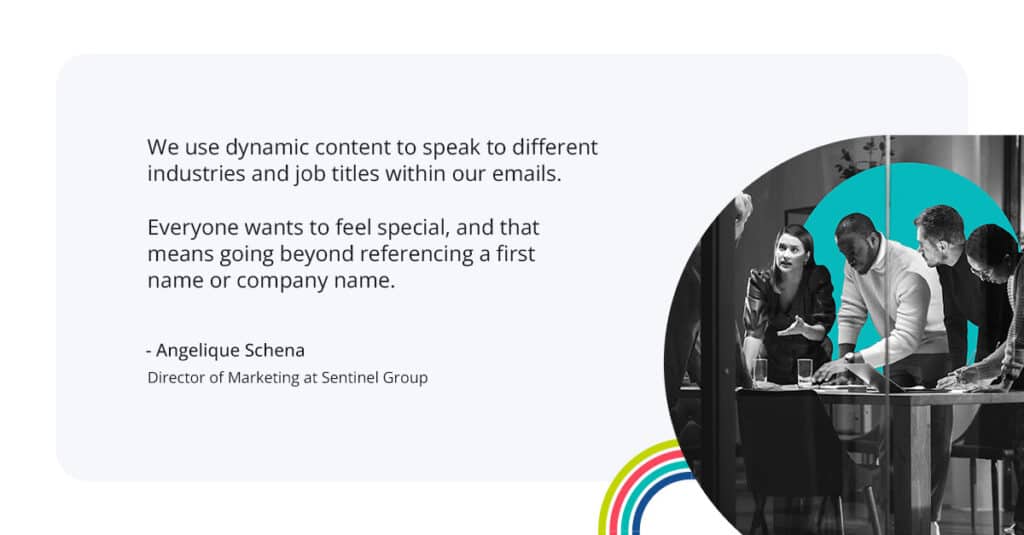
At Daxko, Wendy’s team is using AI to scale up their personalization efforts to the role or persona level. For example, they can feed a customer notification email through ChatGPT, prompt it to personalize the content for multiple personas, and ask it to segment a list of customers. “That’s a simple personalization that we probably wouldn’t have spent time on before, but we can do much faster now.”
As the possibilities of AI-powered personalization increase, Jeff advises marketing leaders to start planning their strategy now — including how to gather and share critical data. “What data are you going to need to accurately drive AI to understand your customer and the business context? If you’re not collecting that information, AI can’t do its job.”
Be ready for what’s ahead
Clark has a final piece of advice for marketers navigating all of these challenges and opportunities: be ready when the market shifts.
“None of these challenges really change that much until the economic crystal ball clears up,” says Clark. “When’s the Fed going to move, or not? Will interest rates continue to fall? That’s what changes access to debt for growth companies and changes the signals that multinational companies read to crank things up. Those factors are what add up to an increased investment. And you can’t do much about that — so what you have to be is ready. Sniff out the opportunities and be ready when the tide turns.”
If your current approach to personalization, retention, or leveraging AI leaves you feeling unprepared, there’s still time to make fundamental — yet economical — changes to your tech stack. Learn more in our guide to switching your marketing automation provider.
Designing a lead scoring model seems like a complex proposition. And if you jump into it without a solid strategy in place, you aren’t going to see game-changing results (or a happy sales team). So let’s break it down. There are clear steps you need to take to build and implement a lead scoring model:
Assemble your cross-functional squad
As we mentioned earlier, lead scoring is a team sport. It’s only useful when all the relevant players are aligned, bought-in, and using the framework on a daily basis. So before you start assigning points and determining thresholds, recruit active participants to help develop your lead scoring framework from the ground up.
In addition to marketing and sales, Suzy Balk, our Sr. Marketing Campaigns Manager, advises that product teams should be included in lead scoring. “If you’re releasing new products or features, it’s important to know what those are because you want to pull in the people who will find them most valuable. So loop in Product, because they will have those insights.”
Know your persona
First things first: make sure your sales, marketing, and other relevant teams (like product) are in agreement on what your ideal customer looks like. This means having well-documented and up-to-date ideal customer profiles (ICP) and buyer personas, which will be essential in step five.
Define your ICP
Think of your ICP like the bullseye in the center of a dartboard. It’s the kind of company you’re going to aim for: the most likely size, industry, and location to benefit from (and buy) your product and services.
You won’t only sell to those kinds of companies — just like you’ll hit the segments surrounding the bullseye during a game of darts — but you’ll prioritize them in your lead scoring by assigning them the highest points.
Create your buyer personas
Your buyer personas are imagined biographies based on firsthand experience, market research, and customer listening. They describe the individuals working at your ICP companies, and give sales and marketing teams a fictionalized human to target with messaging, content, and campaigns.
They also give you a target for lead scoring: you’ll assign points to prospects who most closely resemble your buyer personas when it comes to job title, location, experience level, and other demographic details.
Create a customer journey map
Just as you need to know who you’re trying to reach, you need to know where they interact with your brand along their buying journey. Get everyone aligned with a clear customer journey map: a picture of the most important touchpoints they encounter and steps they take as they move from would-be lead to loyal customer.
Customer journey maps include steps like:
- Downloading a comparison tool
- Reading an ebook
- Checking out a pricing page
- Contacting the sales team or requesting a demo
- Completing a purchase
- Renewing a subscription
The most effective customer journey maps also represent the customer’s mindset or emotional state at each stage, highlighting potential pain points or concerns that marketers can address. These maps can be incredibly simple or very complex, with layers in a heavily matrixed spreadsheet, but having one in place will make assigning behavioral scores in step six much easier.
Plus, companies that use customer journeys are twice as likely to outperform competitors that don’t, likely because it helps teams hone their messaging and content to answer specific needs and questions that arise during the buying process.
Set your lead score scale
Let’s be real here: in a lead scoring model, the numbers are entirely made up. The whole framework hinges on the relative importance of each piece of information or behavior.
You’re trying to answer one question: How important is this factor in terms of indicating likelihood to purchase?
So before you start assigning points willy-nilly, get a reasonable scale in mind. Are you scoring each datapoint on a scale of 1-5? 1-100?
If you’re new to lead scoring, we suggest keeping it simple with a 1/5/10/15 scale:
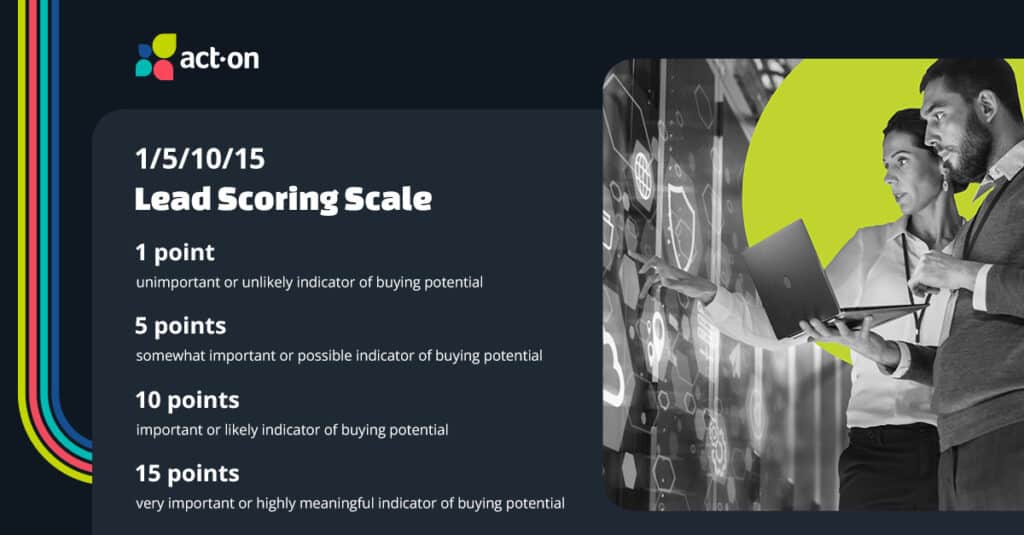
Keep in mind, you’ll also be assigning negative lead scoring points (-1, -5, -10, etc.) to certain attributes or behaviors that indicate a prospect is highly unlikely to buy.
Assign demographic and firmographic scoring factors
Now’s the time to put your ICP and buyer persona data into play. Assign your relative scores for the attributes that matter most to your business, such as:
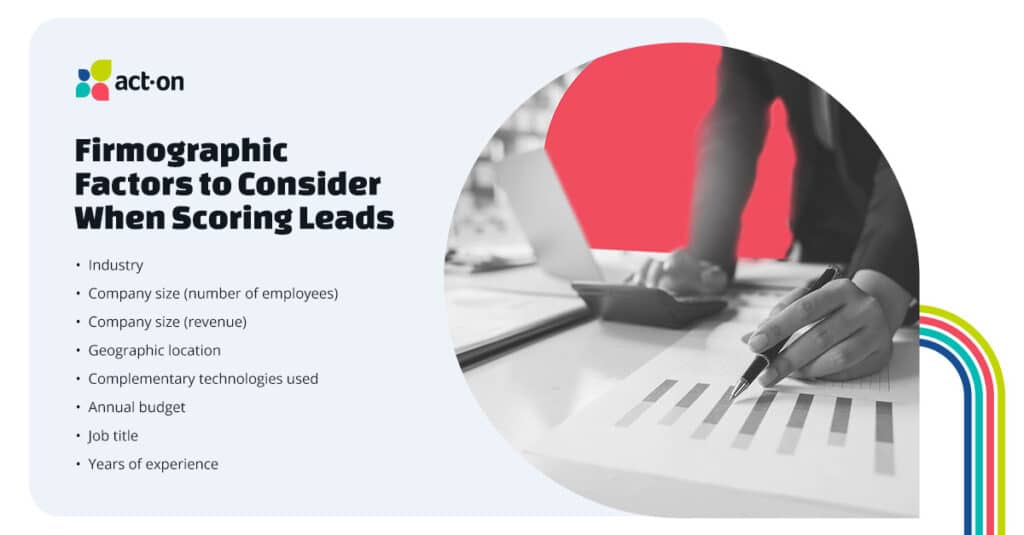
Remember our two imaginary Act-On leads, Debbie (the marketing director) and Tyson (the small business owner)? Let’s score their hypothetical explicit data:
Debbie, the Director of Marketing
- Manufacturing industry: 10 points (this industry is undergoing a digital transformation, so we’re seeing a lot of interest from these companies right now)
- 2000-person company: 10 points (pretty close to our ICP)
- “Director of Marketing” title: 15 points (exactly matches up with our buyer personas)
Tyson, the small business owner
- Restaurant industry: 1 point (not totally irrelevant, but not our ICP)
- 1-person company: -15 points (solo entrepreneurs don’t usually have much budget for marketing software)
- “Owner” title: 1 point (too general to tell us much about the individual, and not one of our buyer personas)
Make your list of firmographic and demographic lead scoring factors as comprehensive as possible for your business, and remember — you can always come back and update your framework later. Do not let perfection get in the way of progress, especially if you’re just getting started.
Assign behavioral lead scoring factors
This is where, in our biased opinion, the lead scoring model really gets fun. By tracking behavior over time, you can assess how interested a lead is in your product, how far along they are in that buyer’s journey, and whether they’re ready to stop reading and start talking.
“Most companies are going to have top-of-funnel content to establish themselves as thought leaders,” says Suzy. “A one-time download of that kind of content doesn’t mean anything from a sales-readiness perspective. If it happens, consistently, now that’s a different story — and that’s where lead scoring comes in.”
Pull out your customer journey map and start to assign points to the different behaviors you can track for your leads. Prioritize the steps that matter most for your business, and get specific about which behaviors show the strongest signal of interest in purchasing:
- Events or webinars
- Registration: medium signal of interest
- Attendance: stronger signal (because showing up demonstrates a more serious interest than merely signing up)
- Website visits
- Homepage: low signal
- About page: medium signal
- Pricing page: stronger signal
- Careers page: negative signal (this person wants a job, not to buy your product)
- Content downloads
- Introductory guide: low signal
- Thought leadership or trends content: low signal
- Strategic how-to content (not product-specific): medium signal
- Product comparison: strong signal
- Product implementation guide: stronger signal
- Traffic or referral sources
- Organic search (product-specific term): medium signal
- Organic search (non-product term): low signal
- Linked from product review site: strong signal
- Customer referral: strong signal
- Social media interactions
- Post like: low signal
- Page follow: low signal
- Tradeshow booth visits
- Scanning badge for a raffle entry: low signal
- Engaging in lengthy conversation: medium or strong signal, depending on the context
- Demo requests
- This is usually a “go straight to sales” action, and should immediately surpass your MQL threshold (more on that in a moment).
Let’s look at another lead scoring example with Debbie and Tyson. Here’s how we would score their implicit data, respectively:

Don’t neglect negative lead scoring
We’ve mentioned negative lead scoring above, but it bears repeating: use negative points to keep unqualified leads out of your sales team’s workflows.
Here are a few more examples of when to apply negative lead scores:
Job titles
A “student” is probably not your buyer persona, and likely warrants a negative score. But an “intern” may be doing research for their employer, and shouldn’t be disqualified altogether.
Missing key data points
If a lead leaves important fields blank, like a phone number or company name, they likely aren’t ready for a conversation.
Email domains
Instead of requiring a business email domain to download content, simply use negative scoring to de-prioritize leads who use personal or .edu emails. You can also de-prioritize leads from your existing customers’ email domains (they would be relevant for customer success, but not sales) or competitors’ domains (you can’t stop the spies from checking out your content, but you can make sure they don’t waste your sales team’s time).
Location
If you don’t provide your service or product to their location, they will never be your customer — so downgrade their lead score accordingly.
Need more ideas? Just ask your SDRs. They know what red flags to look for, and will be delighted to share their expertise.
Set your MQL threshold
This is it. The big moment. Time to set your threshold: how many points should a marketing lead accrue in your lead scoring model before they’re ready to hand over to sales?
Pro tip: make sure this decision is not made in a silo.
Take a look at your assigned points and start doing math on your meeting room whiteboard or your favorite remote collaboration tool. Mock up some scenarios in your shared spreadsheet.
Get sales and marketing to agree:
- How many bottom-of-funnel content downloads?
- How many email clicks?
- Which industries?
- What job titles?
- When are these leads ready to talk to sales?
Once you have the answer, set your MQL threshold.
Adjust your direct-to-sales activities
Now, go back and look at your behavioral lead scoring again. Some of these activities might be direct triggers to sales, such as requesting a demo or filling out a “contact us” form. Adjust that relative scoring to your MQL threshold to ensure every lead who raises their hand to talk to sales does exactly that.
Account for leads that return to marketing
Even with the best lead scoring model in place, certain leads will be handed over to sales that aren’t quite ready to purchase. Maybe they’re highly interested in your product, but are under contract with a competitor for another year. Maybe they provided misleading information when filling out their forms, or don’t have the budget. And maybe they just never answer an email or phone call, going radio silent for no discernible reason.
Unless the sales team disqualifies those leads, they are typically returned to marketing for continued nurturing. In that case, Suzy suggests implementing a “cooling off” period before a lead can be handed off to sales again. “For us, when you’re returned to marketing, you can’t return to sales for 120 days,” he says. Their lead-scoring slate is wiped clean, and they can’t reach MQL status until that time window is up — unless they fill out a demo form.
Evaluate, adjust, and repeat
Congrats! Check the box and give yourself a cookie. You’re all done with lead scoring. Forever.
Just kidding. Lead scoring is not a set-it-and-forget-it program. It’s an ongoing process — and that’s why it works so well.
“The great thing about lead scoring is that it’s a model,” says Suzy. “So after you get some results in, you can always go back and make adjustments. You don’t have to — and shouldn’t be trying to — find the perfect model that will work forever.”
Continue to work with your cross-functional lead scoring squad to monitor progress, track success, and refine your model over time.
How to evaluate lead scoring metrics
Get continual feedback from your sales team on how the lead scoring model is working — both qualitative and quantitative.
To gather qualitative input, have regular meetings, ask about specific channels and campaigns, and keep a conversation going between sales and marketing about what’s working and what’s not.
To measure quantitative success, build a disposition into your CRM that requires specific input from sales when they disqualify a lead. Suzy advises making this field a dropdown list of set options, rather than an open text field, to make analysis easier.
“Maybe the company is too small, maybe the title wasn’t a good fit after all, or maybe they seemed like they weren’t a real person because the SDR couldn’t find them on LinkedIn,” says Suzy. “Here at Act-On, we have a definitive list of possible status reasons that we ask the sales team to use, and a notes field where we can capture additional data.”
Suzy also suggests paying close attention to opportunity creation metrics. By tracking what factors are common across leads that are successfully turned into opportunities, you can identify what factors should be weighed more heavily in future lead scoring.
For example, if the data shows that a large percentage of your opportunities are created within a certain industry, you can go back and adjust your lead scoring to rate that industry highly. Suzy recommends evaluating job titles regularly, too.
“It’s common for companies to prioritize VPs and the C-suite in their lead scoring,” says Suzy. “But I wouldn’t even call those roles ‘decision-makers’. More often than not, a manager or a director makes the call, and brings their decision to the C-suite for approval. So you might be scoring high on the VPs and C-suite, but they typically aren’t the ones who start, engage, and move the buying process forward. And you won’t know that’s the case unless you look at the opportunities and see where they’re being created.”
When to adjust lead scoring
Suzy recommends a regular cadence for updating your lead scoring model—at least quarterly. “Look at your lead scoring regularly and make sure that you’re accounting for changes in the business, new products being released, or larger shifts like a recession.”
Look forward to our next article in this series, where we’ll round up the best lead scoring tools to use in your marketing!
“The personalized attention and emphasis on creating a true partnership with their clients is one of Act-On’s greatest assets.”
Tracy Towns
Sales Operations and Sales Force Administrator
“Act-On brings together all the tools we need in a marketing automation platform. It’s easy to learn, use, administer and manage. Act-On customer and technical support are second to none, truly best-in-class.”
Karen Roscoe
Digital Marketing Manager, Bruker AXS LLC
“It fits perfectly with SalesForce (CRM), seamlessly aligning with Inbound campaigns and automating lead management activities – saving the sales and marketing team valuable time.”
Oliver Morton
Director of Marketing at eDriving
Private: The smartest, easiest to use marketing automation platform
Today’s enterprise marketers need efficient agile marketing automation to help them drive real business results. That’s Act-On.

Go from idea to impact in record time

Agile marketing
Innovative solutions


Real partnership
Learn about our solutions
Everything you need in a marketing automation platform

Email Marketing

Advanced Marketing Analytics

Lead Generation

Lead Scoring

Martech and CRM Integrations
Sales Enablement

Customers Love Act-On
We’ve got the innovative tools, support services, and educational assets you need to succeed.




Act- On pricing: pay for only what you use, period
Number of Contacts in your database
Your estimated Active Contacts (what we charge for)
Our Mission: Help Marketers Get More Done

Support You Can Count On
Fast. Dedicated. Reliable. When our support team hears the call, they drop everything to find a solution to your problem.

A Broad Suite of Professional Services
Whether through Act-On Professional Services or our partner network, we’re here to help you with the tough implementation, migration, or other projects you face.

Best Practices and Benchmarks
Stories of marketing innovation. Benchmarks from peers to guide your projects. Informative guides for even the thorniest topics.
The Stats Don’t Lie

23% of companies switched their marketing automation software provider in 2023!

Marketing teams are only using 33% of MarTech capabilities. That means you’re only getting 33% value out of your marketing automation system.

Companies are reducing their total cost of ownership by up to 55% by realigning their marketing automation to their needs.
Are you ready to make the switch? Assess your total cost of ownership and how much your system is slowing you down.
Why companies are switching

Too Much Complexity

Too Expensive and Increasing Cost

Lack of Investment in Aging Products
The benefits of upgrading…

Get More Done

Reduce Total Cost of Ownership
Not only reduce subscription costs, but also eliminate extra contractors and software needed just to run your marketing automation software. Eliminate hidden overage charges and nickel and diming. Free up budget for other projects or demand gen.

Make the Hurting Stop
The Cost of Inaction
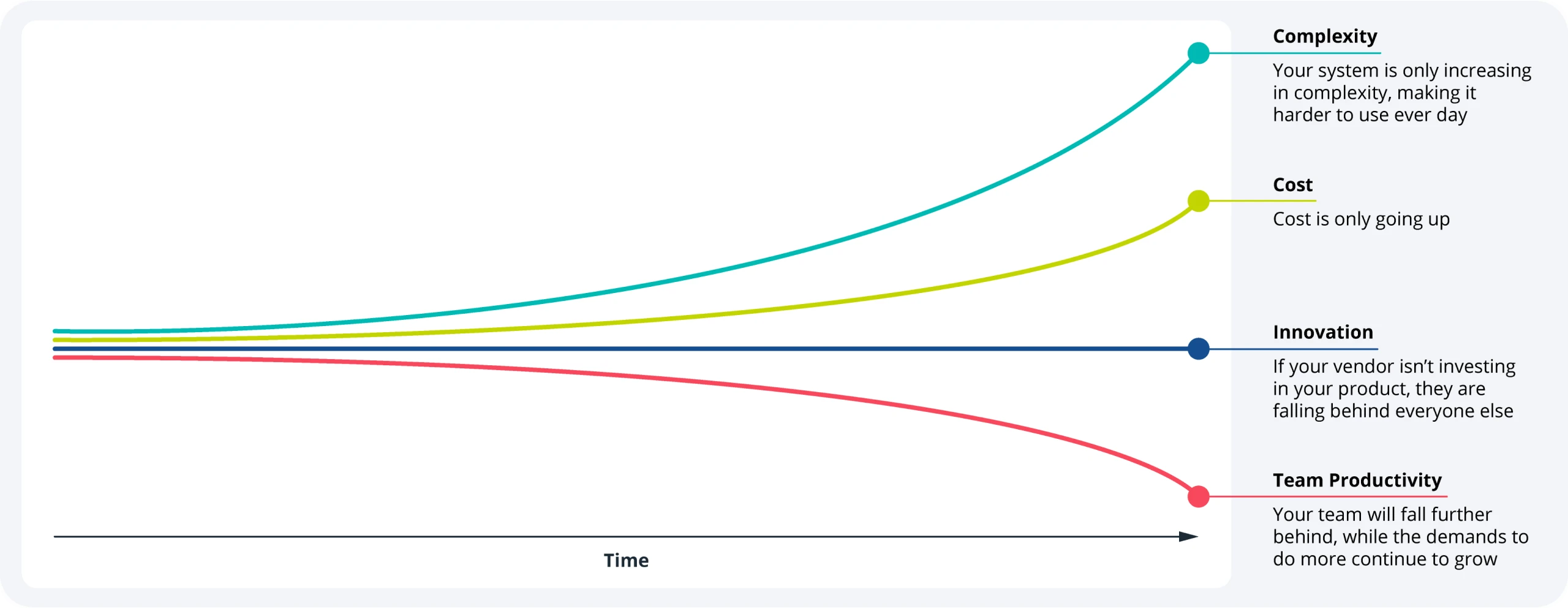
Complexity is only getting worse
Forced Budget Reductions?
What did you have to give up in order to keep your expensive Marketing Automation system? How much did your total cost of ownership go up from last year or the year before? How much do you think it will be next year? (it will be more) What could you do if you reduced your software expenses by 50%?
Team Productivity is Actually Going Down
What does “better” look like?
Worried about Migration? It’s not as bad as you think. Let us show you.
We’ve helped many companies upgrade to a better operating state, reduce cost, and get more done. We’ve developed an effective and proven strategy to “upgrading.” (We have a better solution than “migration”)
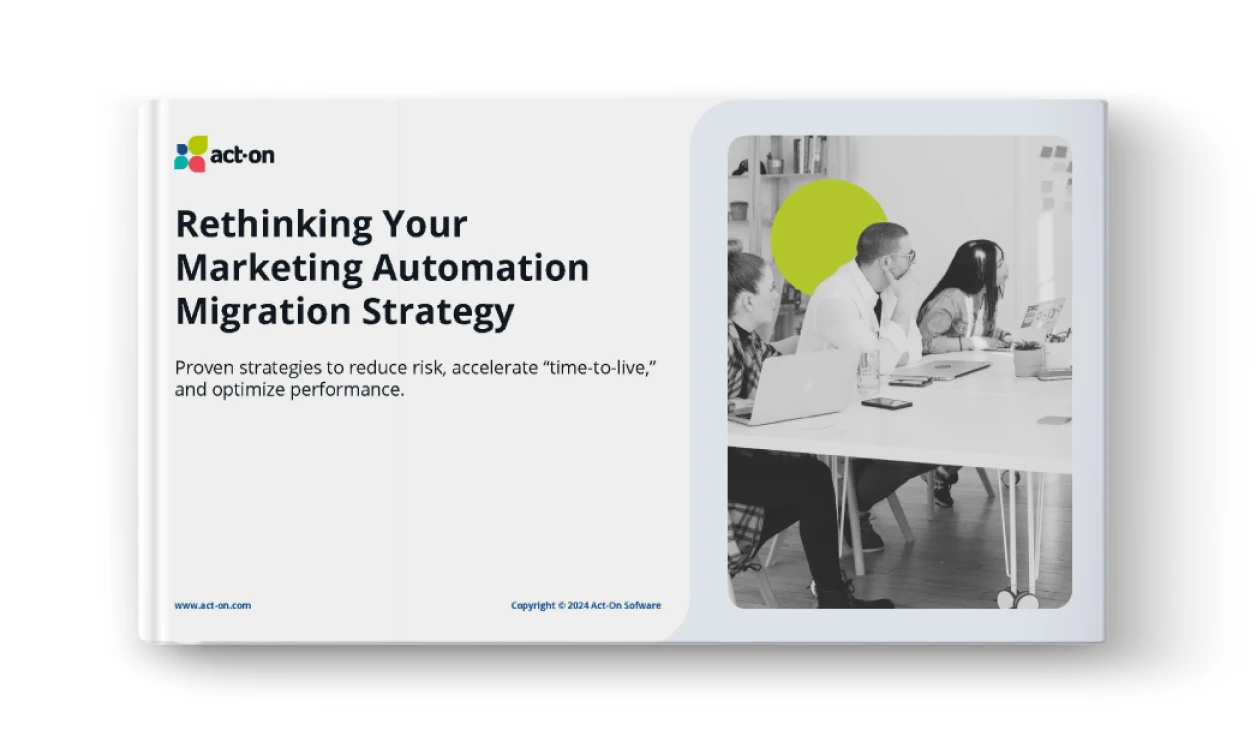
Download our “Migration Strategy Guide”
Use our marketing automation assessment to compare providers and costs
Best Practices for Driving a Marketing Automation Switch
Successful Companies That Trust Act-On:
Platform
Information
©2008-2024 Act-On Marketing Automation
Every year, 23% of companies switch their marketing automation provider.
Do you plan to be one of them? We know from experience that migrating your marketing automation platform can be a difficult, extensive process. That’s why we’re telling companies that make the switch to rethink things entirely: Don’t migrate!
In this extensive thought leadership report, backed by research and featuring interviews with experts, Act-On explains a number of strategic approaches to switching marketing automation platforms that save valuable time and drive marketing operations more quickly to business value.
Read to learn:
- What’s driving the switch from legacy marketing automation platforms
- Why the “migration” approach is outdated, and often not even necessary.
- What we’ve learned from onboarding clients to the Act-On platform, and how you can benefit.
- Several distinct approaches to moving your campaigns and assets to a new system
Contact
Contact Us
Got Questions? Get Answers. Any Time, Day Or Night.
Ready to chat?
Our team is ready to answer any questions you might have! Call our main number: +1 (877) 530-1555 or fill out the form below and we’ll be in touch.
Contact Sales
Contact Support

Portland, Oregon
Address:
121 SW Morrison St.
Suite 1600
Portland, OR 97204
Phone
+1 (877) 530-1555

UK (Remote)
Registered Address:
5 New Street Square, London, Ec4A 3TW UNITED KINGDOM
Phone
+44 1189 515680
Registered Number
8482686
(England & Wales)
Successful Companies That Trust Act-On:

Have You Noticed? Something is Wrong With Your Marketing Automation
The legacy marketing automation solutions aren’t keeping pace with innovation. Think Eloqua, Marketo, and Hubspot. It’s no wonder replacement for marketing automation has been hovering at about 24% of customers for years now.
These providers claim to be packed with the features you need and use. But they’re bloated shadows of their former selves. And it shows in the data. According to Gartner, marketers only utilize 33% of their Martech stack on average.
Innovative Features for Innovative Marketers Like You
Get More Marketing Done
Simplify Your Workflow
Embrace AI-Driven Innovation
Run the Numbers: What Can Switching Providers Get You?
What is Staying Put Costing You?
We get it. Making a switch feels like a big step. But chances are, once you add up the costs of the inefficiencies and missed opportunities, it’s actually costing you more to stay where you are.
Start thinking through the switch with our in-depth guide to marketing automation migration. We have four distinct models for migrating your current programs to a new platform. Every single one is probably a lot easier than you think.

Get the Ultimate Guide to Making the Switch
Successful Companies That Trust Act-On:
Platform
Information
©2008-2024 Act-On Marketing Automation
Is Your Email Marketing Automation Creating Value?
Costs keep going up, and it just gets harder to operate. Complexity surges and value dwindles. That’s the way with bloated legacy platforms. Enough is enough. Stop paying for functionality you don’t even use.
Sound like your marketing automation? You’re not alone. But there’s a better way.
It’s Simple: Get More Done
More Agile Email Marketing
What if Your Marketing Automation Just…Worked?
According to Gartner, marketers are only utilizing 33% of their Martech stack. Why? Legacy marketing automation solutions have become costly and bloated. If you could cut out all the expensive features you never use, you’d have something like Act-On.
Migrating is easier than you think. What if you could be ready to go on your new platform in a manner of weeks?

Find Out How Easy Making the Switch Can Be
What is Staying Put Costing You?
Make the Switch With Confidence
Your Time is Valuable
Take our free assessment to find out what it costs to switch, and to stay put.
Successful Companies That Trust Act-On:
Platform
Information
©2008-2024 Act-On Marketing Automation
Imagine going on a blind date. All you know about the person sitting across from you is their name, maybe what they do for a living, and that your cousin Susan thinks you might get along.
But before you have a chance to ask any questions or get to know them better, they give you a big smile and say, “It’s so nice to meet you. I’d love to show you around my apartment. When’s a good time for you to come by this week?”
How inappropriate! But not entirely unlike when a colleague sends you a link to a gated ebook, you give your contact info to download it, and then get a phone call from a sales rep the same day. You don’t want a demo of their software — you haven’t even had time to read their content yet.
Luckily for marketers, lead scoring exists. Lead scoring helps organizations move prospects along their buying journey in a structured, strategic way — which is especially helpful considering how complex buying journeys have become.
According to research from Gartner, B2B buyers are spending more time researching online, and less time interacting directly with sales — as little as 5-6% of their total buying journey. And it takes an average of 20 touches with a brand before a prospect becomes a potentially successful lead for the sales team.
For marketing and sales teams, that handoff is a potential minefield. Too early, and everyone wastes time. Too late, and potential deals may slip through the cracks.
Lead scoring helps sales and marketing teams navigate handoffs by providing a quantitative approach to qualifying leads: assigning a predetermined number of points to a lead based on certain characteristics or behaviors. Marketing and sales teams can look at a prospect’s lead score and determine whether they’re ready for a sales conversation or need to be nurtured. For example:
- Junior employee downloaded an introductory guide to your general area of expertise? Keep them engaged with more content, and add a few points to their score every time they engage.
- Senior manager visited your pricing page, downloaded a product comparison sheet, and watched a video demo? Score those strong purchase indicators highly and send these white-hot leads to sales.
No guesswork, no gut instinct — it’s all in the numbers.
In this guide, we’ll dive into how lead scoring works, how to build a framework, and the marketing and sales superpowers it can unlock.
How does lead scoring work?
Lead scoring helps organizations avoid the potential headaches of passing leads from marketing to sales — but that only scratches the surface of what a strategic lead scoring framework can deliver.
First, a very quick overview of how lead scoring works. (We’ll give a step-by-step guide to building a lead scoring framework in the next chapter).

Marketing and sales teams usually manage lead scoring within their marketing automation and CRM software, and lead metrics are divided into two categories: implicit and explicit.
- Explicit data is provided intentionally by your lead, such as company, location, industry, and job title.
- Implicit data is observed behavioral information, such as webpages visited, email engagement, content downloads, or form completions. Smart marketers can use these behaviors to deduce what topics a prospect may be interested in, and how close they might be to purchasing.
Every piece of data your team gathers about a lead “earns” a certain number of points. Once a lead crosses a predetermined threshold, they become a marketing-qualified lead (MQL) and your automation software hands them off to sales for one-on-one conversations. The points you assign will depend entirely on your business and your audience.
Lead scoring examples
For example, at Act-On, we sell marketing automation software to SMBs and enterprise organizations. Our leads might look something like this:
- Debbie is the Director of Marketing at a 2,000-person manufacturing company. She entered our funnel through a partner, visited our homepage and about page, downloaded a guide to implementing automation software, and signed up for a webinar about comparing marketing automation providers.
- Tyson is a small business owner. He wants to improve marketing for his local food cart, and entered our funnel through a Google search for “how to do email marketing”. He downloaded our “Introduction to Email Marketing” guide, but never interacted with any of our subsequent nurture programs.
As you can imagine, Debbie the Director of Marketing racked up quite a few points in our lead scoring system, and an Act-On sales rep is primed to reach out to her with some personalized information about our platform.
And while we wish Tyson the small business owner well, his lead score is quite low — and our sales team will never waste a moment of anyone’s time trying to sell him advanced marketing tools he doesn’t need.
(Keep Debbie and Tyson in mind. We’ll use them as examples again.)
The benefits of lead scoring
Now, let’s explore the host of benefits lead scoring delivers — for everyone involved.
A better experience for your leads
Just like overeager blind dates, it’s a big turnoff for prospective customers when a brand comes on too strong or too fast.
For leads at the very beginning of their buyer’s journey, premature sales conversations are intrusive and unwelcome. Lead scoring helps give your prospects the time they need to get to know your brand. This creates a positive experience and builds trust over time, rather than rushing into a sales conversation with a skeptical prospect who has no understanding of what your brand stands for and the value you can deliver.
Less wasted time for your sales team
Qualifying leads takes time. Lead scoring helps your sales team spend their valuable hours more efficiently.
“Having no lead scoring in place is really damaging to a sales team,” says our own Suzy Balk, Sr. Marketing Campaigns Manager. “A good sales rep is going to spend at least three minutes digging into every lead that comes in: what the company does, confirming an individual’s role, and understanding what pain points may exist that resonate with your solution. If your company has a lot of leads coming in, that multiplies out to a lot of time.”
Better follow-up on MQLs
Usually, marketing’s biggest beef with their counterparts in sales is failing to follow up (or follow up fast enough) with their leads.
Now, not to take sides, but if your sales team is swamped with unqualified leads…unsatisfactory follow-up is going to happen. Busy sales reps aren’t going to prioritize marketing-”qualified” leads if you’re actually sending them marketing-”questionable” leads.

With lead scoring, the sales team can have confidence that marketing is handing over leads who are relevant and ready for a conversation. A survey from Gartner reports that 64% of sales reps are more likely to follow up on marketing-qualified leads (MQLs) if the qualification criteria is agreed on in advance.
Which brings us to…
Improved sales and marketing alignment
Sales and marketing alignment isn’t easy to achieve. But lead scoring is a team sport.
Marketing and sales leaders have to work together to agree on the overall framework and specific scoring criteria used to move a prospect along their buying journey. Getting these teams in the same room and on the same page about what makes a qualified lead helps improve communication, collaboration, and accountability.
Better nurturing for marketing
Lead scoring isn’t just about reaching a certain threshold and transitioning ownership from marketing to sales. It also helps marketing teams improve their lead nurturing programs by using lead scores as a layer of segmentation. (More on this below.)
Higher conversion rates for everyone
All these benefits add up to one clear outcome that everyone will celebrate: higher conversion rates for MQLs.
When the sales team talks to a prospect who’s already visited multiple pages across your company’s website, engaged with emails, and interacted with content at different stages of the buyer’s journey, they’re talking to warm leads who are much more receptive to a conversation and closer to making a purchase.
That means a shorter, smoother journey along the sales cycle, a higher likelihood of that lead becoming an opportunity and – eventually – more closed deals.
Now that we know why lead scoring is important and what it can deliver, let’s dive into the nitty-gritty: how to make it happen by building a lead scoring marketing framework.
The Stats Don’t Lie

23% of companies switched their marketing automation software provider in 2023!

Marketing teams are only using 33% of MarTech capabilities. That means you’re only getting 33% value out of your marketing automation system.

Companies are reducing their total cost of ownership by up to 55% by realigning their marketing automation to their needs.
Are you ready to make the switch? Assess your total cost of ownership and how much your system is slowing you down.
Why companies are switching

Too Much Complexity

Too Expensive and Increasing Cost

Lack of Investment in Aging Products
The benefits of upgrading…

Get More Done

Reduce Total Cost of Ownership
Not only reduce subscription costs, but also eliminate extra contractors and software needed just to run your marketing automation software. Eliminate hidden overage charges and nickel and diming. Free up budget for other projects or demand gen.

Make the Hurting Stop
The Cost of Inaction

Complexity is only getting worse
Forced Budget Reductions?
What did you have to give up in order to keep your expensive Marketing Automation system? How much did your total cost of ownership go up from last year or the year before? How much do you think it will be next year? (it will be more) What could you do if you reduced your software expenses by 50%?
Team Productivity is Actually Going Down
What does “better” look like?
Worried about Migration? It’s not as bad as you think. Let us show you.
We’ve helped many companies upgrade to a better operating state, reduce cost, and get more done. We’ve developed an effective and proven strategy to “upgrading.” (We have a better solution than “migration”)

Download our “Migration Strategy Guide”
Use our marketing automation assessment to compare providers and costs
Best Practices for Driving a Marketing Automation Switch
Successful Companies That Trust Act-On:
Platform
Information
©2008-2024 Act-On Marketing Automation
Migrating to a new marketing automation platform can be intimidating. But it doesn’t need to be. Consider first whether you even need to perform a full migration. Changing providers offers a unique opportunity to take a look at your current programs and lists and determine what’s working, and what’s not. You might not need a full migration.
Once you are 100% confident in the need for a change, it’s crucial to make sure the migration process goes well. Use this article as your guide for a smooth transition for marketing automation migration.
Gather critical assets for marketing automation migration
A successful migration starts with gathering your critical assets. Inventory what assets need to migrate to the new platform and which assets you’ll discontinue using. As you create your list, consider the following:
- Take inventory of templates. What templates do you currently use in your marketing automation program? Do you use email templates? Landing page templates? Make a list of all templates that need to migrate to the new platform, and include screenshots and design elements whenever possible.
- Evaluate your existing nurture programs. What automated programs do you have in place, and which programs will you migrate to the new system? Gather all relevant assets that need to migrate in order to continue your existing nurture programs.
- Gather media assets and images. One of the biggest sources of migration pain is making sure your marketing content comes over too. From ebook PDFs to logos, icons, and even stock images, one of the best ways to ensure a smooth migration to your new marketing automation platform is to make sure you inventory and organize all of it.
- Pro Tip: Create a complete inventory of media and visual assets with a Google Sheet, and save the assets into an organized system of folders using Google Drive, with appropriate file names. At that point, whoever is helping you migrate will have an excellent source of truth on what to move and where it is.
- Reference existing branding requirements. Most established marketing departments have strict branding guidelines, and it’s important to keep those guidelines front and center as you migrate and re-create assets in the new marketing automation system.
- Create a list of integrations. What integrations are needed in the new system? First, make a list of the existing technology stack. One of the most important integrations is with your CRM tool.
Marketing automation migration process and support
As you shop for a marketing automation partner, ask about the process of re-creating assets in the new system. This process should be simple so that your team can quickly re-create the relevant assets. Ask your new marketing automation provider for a demo of the re-creation process to understand the ease of use and how you can get your assets into the new marketing automation platform.
Also, think through how you’ll organize the assets. Create folders for each asset type, and then download all relevant files to a specific folder using a zip file. This process makes it faster and easier to group relevant assets. Finally, consider file naming during the migration. As time progresses, marketing staff may come and go, and it’s important that new team members be able to find the files they need through proper naming and organization.
Identify contacts and lists to migrate marketing automation

You have an inventory of assets that need to migrate to the new system. Now you need to consider how your contacts and lists will migrate. Unfortunately, many organizations make the mistake of trying to pull lists from their already-segmented CRM. Although this process works, there is a more effective method to save time and improve data integrity.
Try creating a list of all contacts that is not segmented in your CRM. You can then pull this single list into the new marketing automation tool and segment people using the new tool. This keeps things simple and gives you the valuable opportunity to cleanse the data. Existing databases may have duplicate contacts, creating inefficiencies in your marketing programs. Migration is the perfect time to clean up this duplicate data.
A final tip for identifying contacts to migrate is gathering a list of opt-outs. You can download this data from your existing platform so that you don’t inadvertently contact people who previously requested to opt out. Not only will this keep you compliant with important regulations, but it also will help contact only recipients who are interested in receiving your messages.
Prevent future challenges by locating stakeholders early
One of the most important steps for a seamless migration is identifying stakeholders early in the migration process. Locate “champions” in critical departments (usually including sales and IT, in addition to marketing) to help keep your project moving.
Setting up technical requirements can be frustrating without the support of IT. Schedule a kickoff meeting with relevant departments, and find the appropriate point people in each area to help with migration. For example, you need contact with the Salesforce administrator and the CRM administrator in your company to ensure the integration with your new marketing automation platform runs smoothly.
Additionally, identify who has permission internally to complete website-related tasks, such as implementing beacon tracking. For example, a marketing department may have a team member internally trained to complete this task, but the responsibility often resides in IT. At times, marketers need to navigate several IT layers to complete beacon tracking. Identifying the right person and processes early helps build the appropriate lead time to complete tasks and keep your projects on schedule.
Avoiding common marketing automation migration mistakes

Marketers often delay migration due to worries about the process, but the good news is that migration can be smooth and easy with a good partner. A critical component is an experienced onboarding team that understands common migration pitfalls and how to avoid them. Common problems include:
- Bringing your CRM point person late to the party. CRM integration is a common trouble spot for marketers during migration, but it doesn’t have to be a challenge. Instead, bring your CRM information technology contact into the loop early, so if you encounter any challenges, you can move through them quickly.
- Doing too much too fast. A tried-and-true approach that marketing automation experts take is moving in phases. Your onboarding team should talk about your most important goals and guide you to achieving those goals using a strategic and phased approach.
- Not having the proper support. During the early weeks of migration, you need a dedicated training team. This team should spend time getting to know your goals and helping chart a clear path to meeting those goals quickly.
Measure your results along the way so you can iterate as necessary and get the most from your new solution. For example, most marketers (61%) identify lead generation as a top goal. So if your goal is lead generation and you’ve generated 1,000 new leads after the marketing automation migration, you’re likely on target. If not, you can often make small changes to improve results, and a good partner can support you along the way.
Finally, remember to test, test, test. The risk for error exists with any tool, which is why the testing process is so important. Every team uses marketing automation differently based on goals. Test tracking codes, and pay specific attention to email formatting. For example, if you’re sending emails, make sure the format is consistent across different email clients. Testing will ensure that you avoid the potential stress and wasted time associated with fixing mistakes and dealing with the potential fallout.
Assembling the team for foolproof marketing automation migration

Not all marketing automation paths are created equal. Support is a huge variable in ensuring an easy migration process. A critical question to ask when shopping for a new solution is “What happens after I purchase the solution?” The answer should focus on connecting you with strong migration, onboarding and training resources to ensure your success.
Training should include several one-on-one sessions that focus on your immediate goals and how to get value from the new tool quickly. Additionally, you need resources, such as webinars and on-demand training, that will continue to guide you along your journey. This will ensure that you transition to the new tool easily and begin experiencing results faster.
Increasing performance throughout the sales funnel
Migrating to a new marketing automation tool can help you capture more leads and give you back a valuable resource – time.
During the migration, you have an opportunity to evaluate your existing programs and determine what’s working and what isn’t. In a sense, it’s a time to “clean house.” You can strategically select the best programs to bring to the new solution, cleanse your existing data, and ensure that data integrity is achieved.
Additionally, migrating to a new solution provides the opportunity to increase performance at every step in the sales funnel. Increase conversion rates and customer engagement, and nurture customers throughout every stage in their journey. The result is that customers will experience more relevant interactions and build stronger and more meaningful relationships with your business.



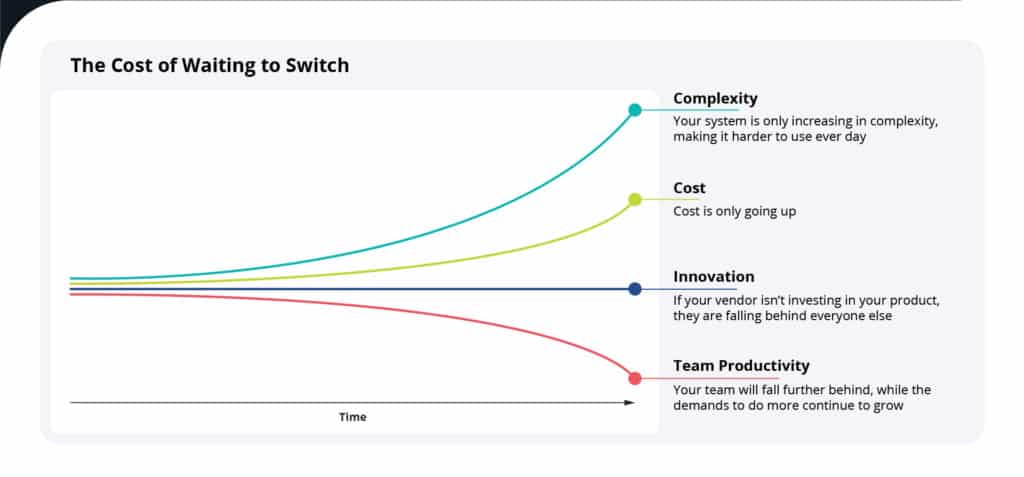
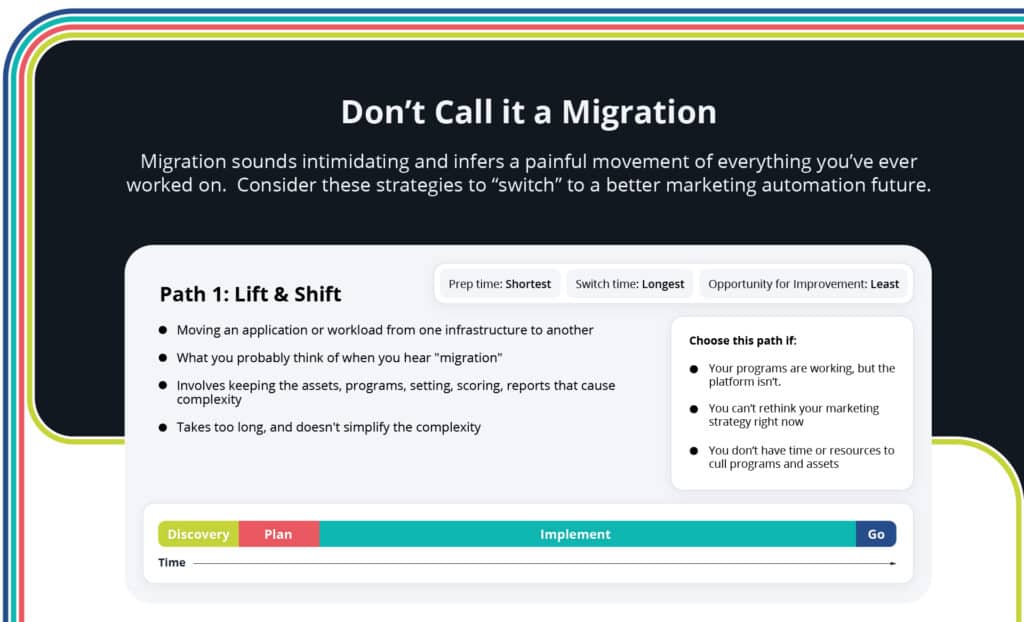
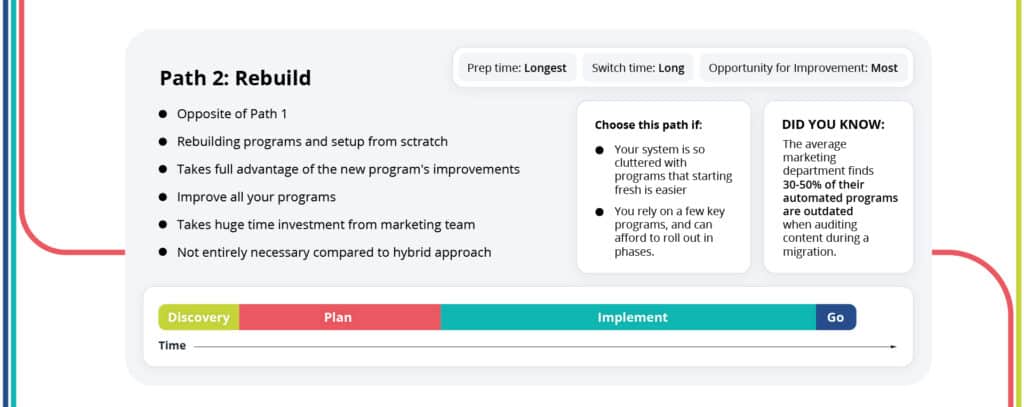
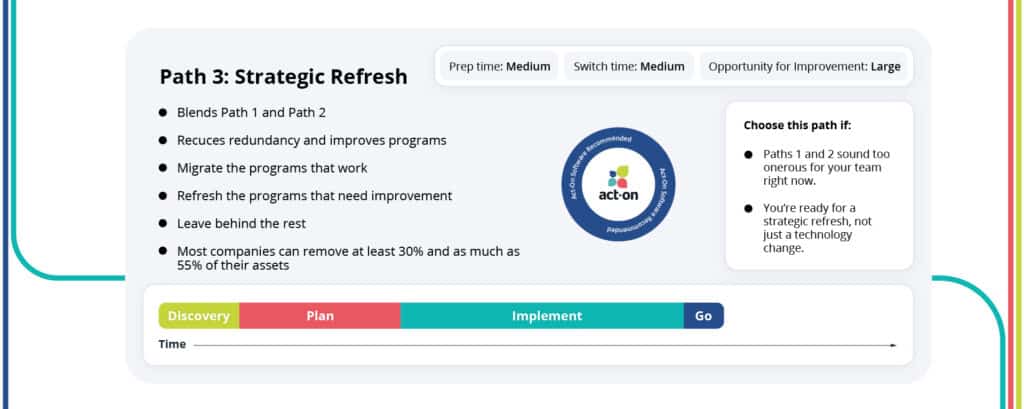
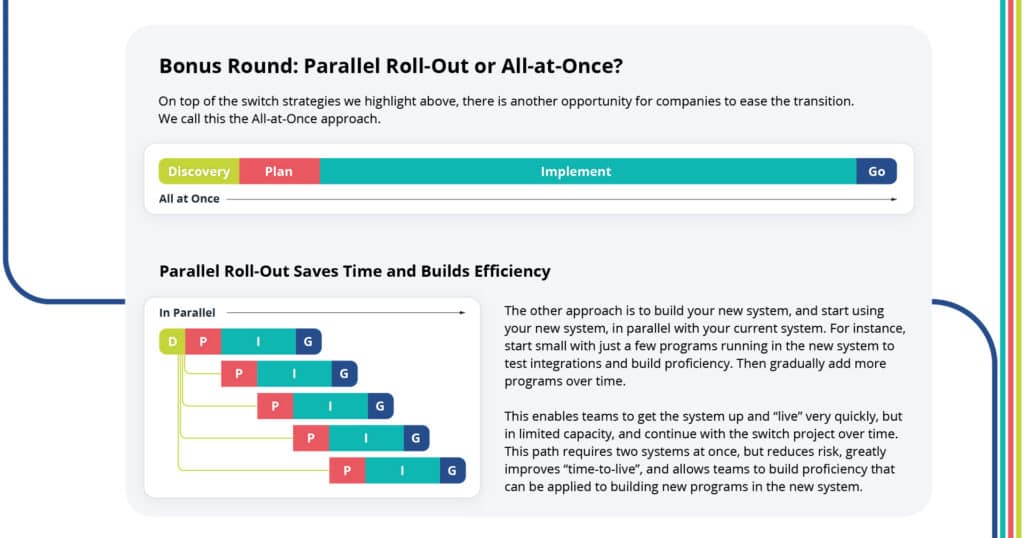
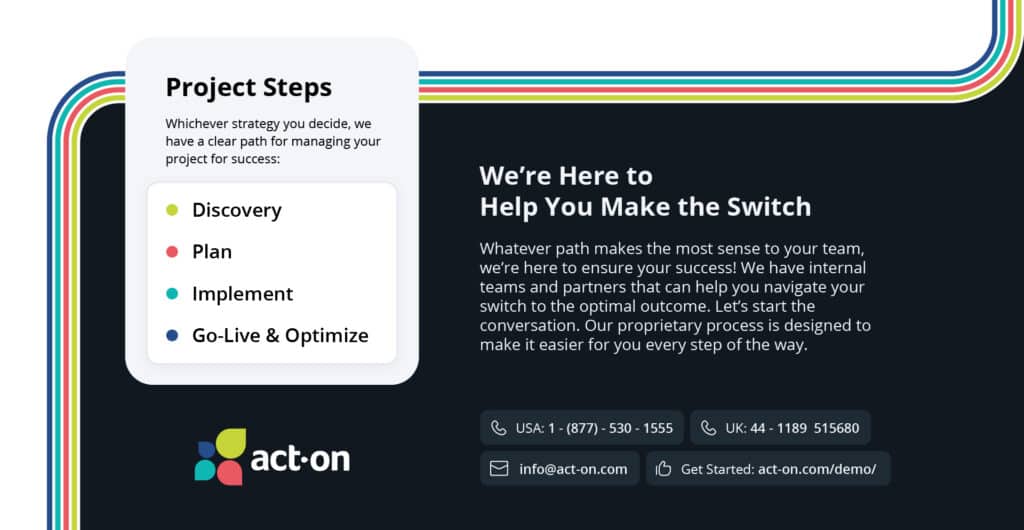
Rising ROI expectations, increased inflation, and decreased consumer spending all add up to a CMO role that is quickly evolving.
“Surveys show CMOs are concerned about demonstrating ROI, with another significant challenge being the generation of leads,” says Jeff Day, SVP of Marketing at Act-On Software.
As CMOs create strategies to solve these challenges in the coming months, their role is also evolving. CMSWire surveyed 700+ marketers and found the future will require:
- Increased cross-functional partnerships with sales
- More pressure to improve customer experience
- More robust data strategies
As leaders focus on these areas and build stronger pipeline generation, a few strategies can help increase success while navigating economic headwinds.
Cross-functional partnerships with sales and pipeline generation
Leaders are familiar with the age-old rift between sales and marketing. The disconnect becomes especially apparent when it comes to missing revenue targets. You might hear things like:
“Sales isn’t following up! We worked so hard to get those leads… .”
“Marketing keeps sending us all these terrible leads; we’re sick of wasting our time!”
However, this apparent challenge is actually a huge opportunity. And the key to capturing it is shifting from quantity to quality.
We recently talked with Kevin Butler, VP of Marketing & Strategy at Goose Digital.
He noted the need to consider MQLs in the context of your total addressable market (TAM). “When you look at your MQLs, does that number make sense with your TAM?” asks Kevin. “Your team might say, ‘We drove 4,000 leads this month.’ But what if there are only 200 companies in your target market? How is that possible?”
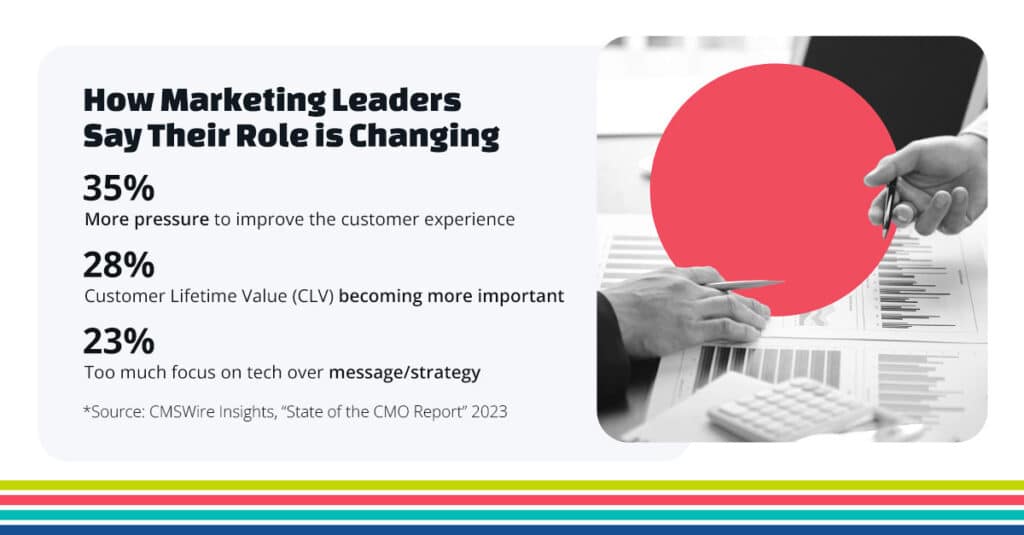
Part of this goes back to your lead-scoring system and talking with your sales team to ask questions like:
What’s a “good lead” for you?
Which leads are the easiest for you to make contact with and qualify?
For marketing, that might mean narrowing the focus to provide higher-quality leads, and sales might need to dive deeper and get specific about what makes a good lead.
Improving the customer experience and pipeline generation
Not surprisingly, survey respondents said another key factor that would shape a CMO’s role in the future is the customer experience. However, according to leaders, when considering experience improvements, they face two major challenges:
- Lack of budget
- Difficulty measuring ROI in marketing
Jeff explains that “cautiously optimistic buyers expect more value from their purchases in the current environment.” Building that value starts with nurturing prospects and continues long after the purchase.
As prospects and customers explore your website, open your emails, and engage on social media, they leave “digital breadcrumbs.” Collecting and knowing how to use this data is your team’s gateway to improving the customer experience.
For example, if you sell marketing automation, perhaps an existing customer attends a webinar about email deliverability and then downloads an eBook on the same topic. Tracking that behavior, your team can trigger campaigns to send that customer the most relevant resources to build pipeline and future cross-sells and upsells.
You can also track behavioral data to identify prospects with a high sense of urgency. For example, a prospect who visits a product pricing page several times in a single day might receive a message asking if they’d like to connect with a salesperson. Allowing the prospect to self-identify their needs helps improve the experience.
Additionally, you’ll want to reconsider how you’re collecting first-party data. Marketers often ask for information such as name, email address, and phone number when gating content. However, according to Kevin, they rarely collect answers to questions like:
- When are you looking to make a purchase?
- What is your greatest need?
Gathering this information helps you build a stronger marketing pipeline that focuses on quality instead of quantity. It also helps you provide a better customer experience by identifying prospect interest and intent early.
More robust data strategies and pipeline generation
When asking marketing leaders about metric accountability, the survey found that:
- 59% reported that leadership expects “marketing to have quantifiable, measurable results for everything in the department.”
- 41% said that “leadership accepts that some of the goals may not have quantifiable results.”
Regardless of how your leadership team approaches results, marketing teams still face budget concerns, doing more with less, and demands around scaling.

As you work to overcome these challenges, marketing automation is a tool that helps you understand your audience’s needs, supports pipeline marketing, and provides sales with better leads.
The challenge is that many marketing teams use tools that don’t adequately support their needs.Gartner shows that only 33% of marketers fully use their martech stack, which means that many teams pay for capabilities they aren’t using (hardly a good thing when budgets are shrinking).
“Martech vendors, racing to build bigger and better features, ended up with so much “extra stuff” in their suites that getting even the most basic work done—let alone anything complicated—became difficult,” says Jeff. “The result is frustration and wasted time.”
This frustration is likely why 23% of marketers report they switched their marketing automation solution for a better alternative.
And at the end of the day, when you sit down with your CEO to discuss marketing strategies, they want to know:
How does this program, strategy, or campaign translate to dollars?
“When you can leverage data-driven strategies with tools like marketing automation, it’s easier to answer that question,” says Jeff. “But you want to use tools that have the capabilities you need, instead of paying for functionality you don’t want or need.”
If you’re concerned about the rising cost of operating your marketing automation along with increasing complexity, check out our free marketing automation assessment tool. It will guide you to calculate the business benefits of a more efficient solution to navigate the way forward.
Join Act-On’s VP of Marketing, Casey Munck, as she moderates a panel of marketing leaders, during our recent Revenue Kickoff, in a discussion of what’s top of mind in the year to come.
In this On-Demand Webinar we uncover:
- What CMOs are most concerned about for 2023
- What are the hot topics in marketing now
- How sales and marketing teams can better work together
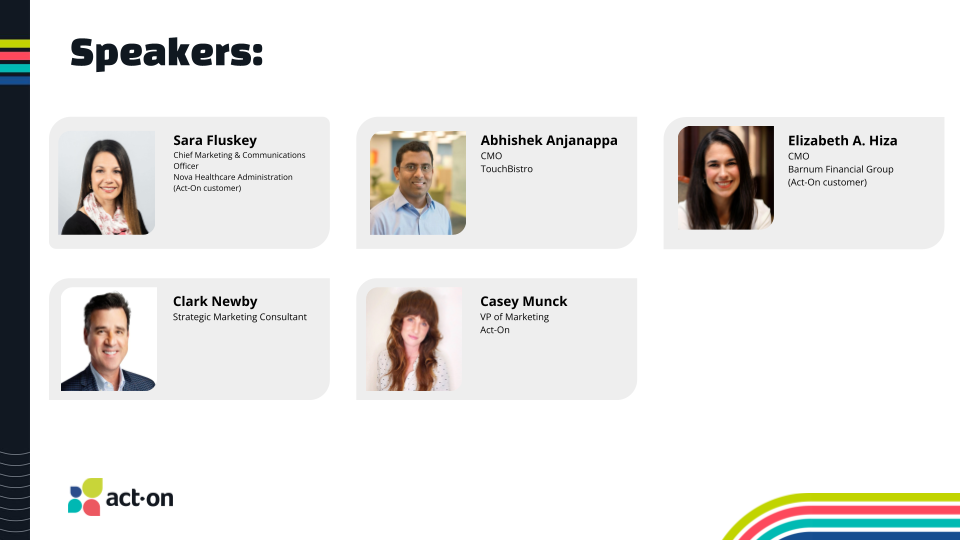
Act- On pricing: pay for only what you use, period
Number of Contacts in your database
Your estimated Active Contacts (what we charge for)
Our Mission: Help Marketers Get More Done

Support You Can Count On
Fast. Dedicated. Reliable. When our support team hears the call, they drop everything to find a solution to your problem.

A Broad Suite of Professional Services
Whether through Act-On Professional Services or our partner network, we’re here to help you with the tough implementation, migration, or other projects you face.










